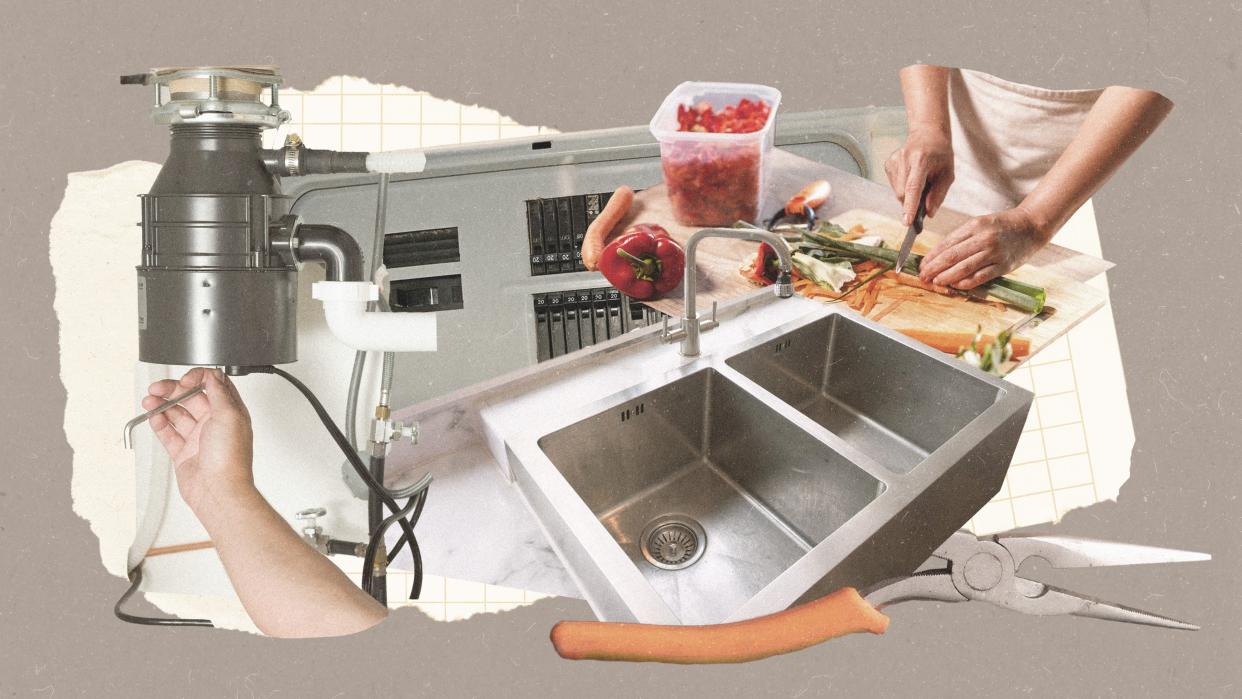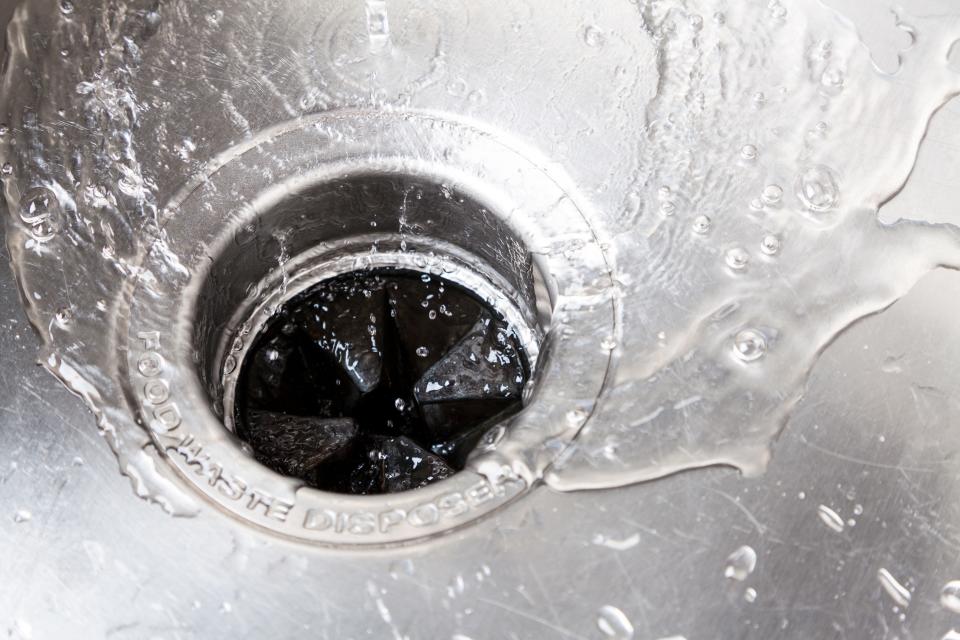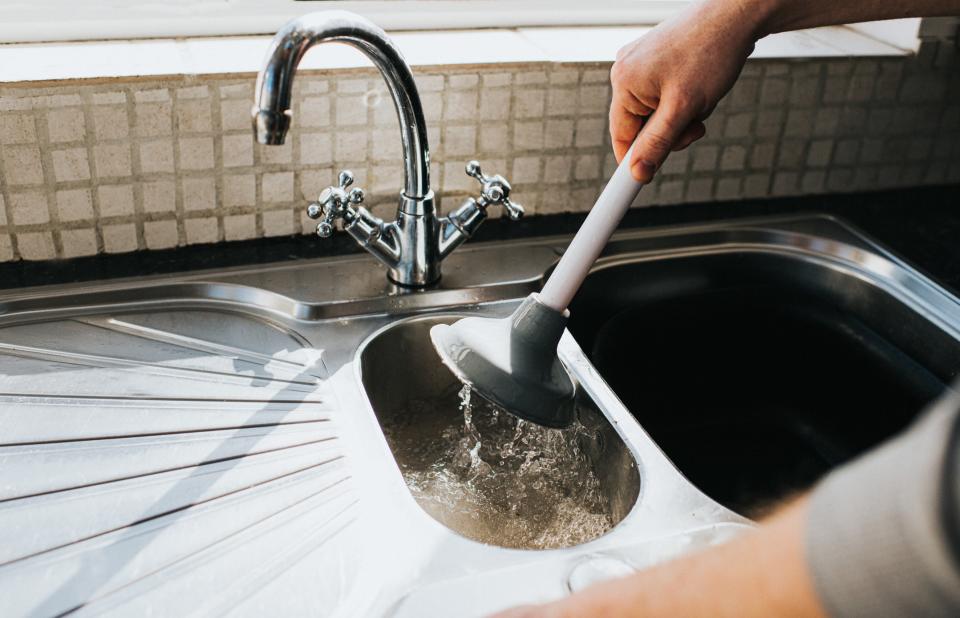How to Fix a Garbage Disposal Yourself

Illustration: Ellie Schiltz/Getty Images
You probably spend almost no time thinking about the disposal in your kitchen sink. But as soon as that sink drain backs up, how to fix a garbage disposal rockets to number one on your cleaning to-do list—after all, garbage disposal problems can be inconvenient and dirty affairs, with rank odors wafting up and soiled liquid dripping from the drain pipe below. Fortunately, a broken garbage disposal is often a DIY-friendly issue that you can address with common household tools (like tongs, an Allen wrench, and needle-nose pliers) and kitchen basics (like salt, ice cubes, vinegar, and baking soda).
Before you’re off to start troubleshooting your garbage disposal repair yourself—or assessing whether it’s a case for a professional—we checked in with some plumbing experts to get their best advice for fixing up that troublesome garbage disposal unit of yours.

Kitchen sink
What is the most common cause of a malfunctioning garbage disposal?
“Jammed disposals are the most common issue with garbage disposals,” says Docia Boylen, the owner of Handyman Connection of Golden. “The disposal will make a humming sound and your sink may not drain fully. Common reasons for this are jammed food—like fruit pits, eggshells, stringy vegetables, bones—or nonfood items that get in there.”
Before we jump into the specifics on how to fix a garbage disposal, note that sometimes it’s simply a power problem and your garbage disposal unit may actually be in fine shape. “Many times, garbage disposals are plugged into the GFCI outlet for water safety purposes,” says Korey Gregory, superintendent of ASAP Restoration LLC. “If this is the case, it may simply need to be reset so that there is power going to the unit again. Press the GFCI button in the middle and test the disposal again.” Also, before you call—and pay—the electrician, check the breaker box for a tripped circuit breaker. (And make sure the disposal is plugged in and switched on.)
While each of the experts we spoke to offered a few unique bits of advice, they all agreed on one thing above all else: No matter what might have made your garbage disposal stop working, unplug it from its power source before you try to fix it. Safety first, DIY repair second!
How can you prevent garbage disposal jam?
Allison Harrison, co-owner of Goodbee Plumbing, explains that proper garbage disposal use can prevent issues in the first place. “The first rule of owning and operating a garbage disposal is to always run cold water while the unit is in use and for 20 to 30 seconds after the disposal is switched off,” she says. “Cold water keeps the motor from overheating and allows the food waste to flush through properly. And avoid certain foods; though kitchen garbage disposals are powerful devices, some foods are better suited for the trash can than the sink.”
How to clear garbage disposal jams
If you hear a humming sound when you try to run your garbage disposal rather than its usual throaty roar, it’s almost certain you have a jam. Disconnect the unit from power, then have a look inside using a flashlight. If you can see something physically stuck in the disposal blades, you can try to dislodge it using needle nose pliers or a pair of tongs—don’t stick your bare hand in there, though!
If you can’t clear the jam from above or if you can’t see an obvious cause, you can often manually rotate the impeller blades from below, potentially clearing the jammed object. “You can check if your garbage disposal can be unjammed,” says David Lewis, owner of Mission AC and Plumbing. “Grab your Allen wrench or that tool that came with the unit. Stick it into the [small hole] at the unit’s bottom, and then give that impeller a little spin.” If you can move the blades around a few rotations, then you should be able to run the water then turn the disposal on as usual. Check again to see if there is a physical object that can be removed after manually rotating the blades and before running the unit.
For units that do not have a place for a wrench on the bottom, you may be able to manually turn the blades with a thick wooden spoon, achieving the same result.
Fixing garbage disposal clogs
If your disposal sounds like it’s working but the sink is backing up and water is not draining properly, you likely have a clog, not a jam. The easiest way to clear a clogged kitchen sink is with a plunger.

Plunging a Sink
“First, fill the sink partially with water to cover the plunger’s lip,” says Kent Boll, founder of Service Today. “Then pump the plunger up and down several times to create suction and pressure. After a few plunges, pull it off to see if the water drains. Don’t use a toilet plunger because, first of all, you can transfer bacteria to your kitchen sink from a toilet, and secondly, toilet plungers have a different design, making them ineffective for unclogging garbage disposals.”
If the plunging does not work, the clog is likely further down below the disposal. “In some cases, a clog is not in the garbage disposal itself but in a P-pipe,” says Boll. Also called the “P-trap,” this is the curved piping below your kitchen sink, so shaped to prevent odors from wafting into your home. You can unscrew this section of piping and look for a clog. Often, it can be unscrewed by hand, but a pipe wrench will make short work of the process.
“Don’t forget to place a bucket under the P-trap to catch water,” Boll says, adding: “If the clog is even deeper down the drains, use a plumber snake.” And if that fails, use a plumber.
Power problems with garbage disposals
If your disposal motor will not even try to kick on, then you have a power issue that could be caused by something as simple as a flipped switch or as terminal as a completely dead unit (ideally one that’s still under warranty).
First, make sure the disposal is plugged in and, if it has a power switch, that the switch is flipped on. Next, confirm the outlet to which the unit is connected is working by plugging in a device you know is functioning to the same power source. You may need to reset the outlet with the button in its center.
If all that fails, make the trip to the circuit breaker box and check for a tripped circuit breaker. If none of these steps gets power flowing through your unit, it may be time for a new garbage disposal.
Garbage disposal repair FAQs
What kinds of foods should never go into a garbage disposal?
It’s a pretty long list, actually. “Never pour leftover cooking fat, oil, or grease down the drain,” Harrison says. “While it remains liquid on the stovetop, it will congeal and clog your pipes once it cools. Coffee grounds can similarly cause clogs as they accumulate. Other foods to avoid include fibrous vegetables, such as celery, onion skins, artichokes, and asparagus. Animal matter such as fish or chicken bones, eggshells, and seafood shells should also go straight into the trash.”
How do I clean a garbage disposal?
“Basic cleaning of your disposal is easy,” says Boylen. “Just run hot water from the faucet, put dish soap into the drain, and then turn the unit on for a few seconds.” You can perform a more intense cleaning that can clear out stubborn bits of food waste by tossing a handful of ice cubes, adding a large scoop of course salt, then running the water and switching the disposal on. Adding baking soda and vinegar to a disposal and running it can clean the unit and reduce odors.
How long do garbage disposals last?
Garbage disposals are hearty machines. Many last as long as 15 years. The average “lifespan” of a garbage disposal is usually close to 8 to 10 years—still quite a good run for a device you use all the time that often costs well under $100.
When should I replace my garbage disposal?
When your garbage disposal isn’t working properly and can’t be fixed using any of the methods laid out here, it might be time to replace it. The fact is, getting a brand new garbage disposal will likely cost less than the labor charge you’d get from a professional plumber, so replacing a failing unit is the better move financially, if you cannot repair it yourself.
Originally Appeared on Architectural Digest
More Great Stories From AD It Yourself
47 Kitchen Organization Ideas That Declutter Cabinets, Countertops, and More
The Cringiest DIY Trends According to TikTok’s Favorite Designers, Decorators, and DIY’ers
How to Propagate Pothos Plants at Home: A Step-by-Step Guide
Not a subscriber? Join AD for print and digital access now.
Browse the AD PRO Directory to find an AD-approved design expert for your next project.

